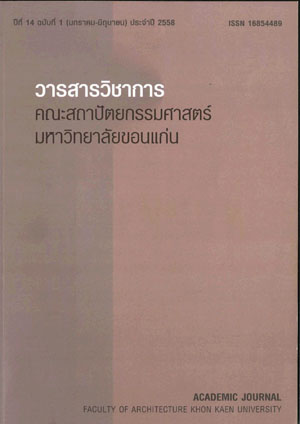ประสิทธิภาพวัสดุและการเว้นช่องว่างเพื่อการลดความร้อน ด้วยระแนงแนวนอน
คำสำคัญ:
ระแนงบังแดด, อุปกรณ์บังแดด, อาคาร, Lathing, Shading Device, Buildingบทคัดย่อ
งานวิจัยนี้มีจุดประสงค์เพื่อศึกษาถึง การลดความร้อนเข้าสู่อาคารด้วยการใช้ระแนงบังแดดแนวนอน โดยวิธี การศึกษาภายใต้สภาวะจริง ด้วยหุ่นจำลองที่มีผนังทดสอบเป็นผนังทึบไม่มีช่องเปิด ติดตั้งแผงกันแดดโดยใช้ระแนง หน้ากว้าง 3 นิ้ว ติดตั้งห่างผนัง 0.30 เมตร หันหน้าไปทางทิศใต้ การศึกษาที่ 1 เปรียบเทียบการติดตั้งระแนง ไม้จริง ไฟเบอร์ซีเมนต์ คอมโพสิทไม้ผสม พลาสติค และแผ่นอลูมิเนียมพับ โดยใช้ระยะเว้นช่อง 1 นิ้ว ผลคือ ระแนงแผ่น อลูมิเนียมพับลดความร้อนได้มากที่สุด รองลงมาคือ ไฟเบอร์ซีเมนต์ คอมโพสิทไม้ผสมพลาสติค และไม้จริง ตามลำดับ การศึกษาที่ 2 เปรียบเทียบสีและพื้นผิวระแนงแผ่นอลูมิเนียมพับ 3 ชนิด คือ อบสีขาว ทาสีขาวด้าน และไม่ทำสี ผลคือ ระแนงอบสีขาวมีอุณหภูมิผิวต่ำที่สุด ต่ำกว่าระแนงทาสีขาว 0.4 oC และตต่ำกว่าระแนงไม่ทำสี 3.5 oC การศึกษาที่ 3 เปรียบเทียบการติดตั้งระแนง แบบไม่เว้นช่อง เว้นช่อง 1/2 นิ้ว 1 นิ้ว และ 1 1/2 นิ้ว ผลคือ แบบมีการ เว้นช่องทั้ง 3 ตัวอย่างมีอุณหภูมิใกล้เคียงกัน มีอุณหภูมิต่ำกว่าแบบไม่เว้นช่อง 0.6-1.0 oC การศึกษาที่ 4 เปรียบเทียบ การติดตั้งระแนง เว้นช่อง 1 นิ้ว 2 นิ้ว 3 นิ้ว และ 4 นิ้ว ผลคือ การติดตั้งระแนงแบบเว้นช่องทั้งหมดมีอุณหภูมิใกล้เคียงกัน อุณหภูมิต่ำกว่าแบบไม่มีระแนง 1.0-1.4 oC การติดตั้งแบบเว้นช่อง 2 นิ้ว สามารถป้องกันความร้อนเข้าสู่อาคารได้ดี ที่สุด แสดงให้เห็นว่า การใช้ระแนงวัสดุทึบแสง สามารถลดความร้อนเข้าสู่อาคารผ่านผนังทึบได้ โดยมีประสิทธิภาพ ต่างกันตามคุณสมบัติวัสดุ การใช้สีโทนอ่อนและผิวมันวาว จะทำให้ป้องกันความร้อนได้ดี การติดตั้งทุกระยะเว้นช่อง สามารถลดความร้อนเข้าสู่อาคารได้ การติดตั้งแบบไม่เว้นช่องจะทำให้ประสิทธิภาพการป้องกัน ความร้อนต่ำกว่าแบบ เว้นช่องว่าง ระยะเว้นช่องที่เหมาะสมคือ 1/2-4 นิ้ว เนื่องจากสามารถลดความร้อนได้ใกล้เคียงกัน สามารถปรับใช้ได้ ตามความเหมาะสมในด้านอื่นๆ และรูปแบบที่มีประสิทธิภาพสูงสุดสำหรับการศึกษานี้ คือ ระแนงแผ่นอลูมิเนียมพับ สีขาวเคลือบผิวมัน ระยะการเว้นช่อง 2 นิ้ว
The Efficiency of Materials and Space for Heat Gain Reducing in Horizontal Lathing
Suntipap Pearnok and Chumnan Boonyaputthipong
The purpose of this research study is experiment heat-gain reduction methods with horizontal lathing in real situations by using models. It was 3 inch lathed, mounted 0.30 meter from models wall and turned to the South. In the first study, the models were compared with four types of materials (i.e. woods, fiber cement, composite wood & plastic, and aluminum sheet). The study results showed that the aluminum sheet had the highest efficiency followed by fiber cement, composite wood & plastic, and woods. In the second study, the color and surfaces of three types of aluminum sheet lath (i.e. glossy white, matt white, and nature aluminium anodise) were compared. The study results demonstrated that the glossy white lath’s surface had the lowest temperature. It lower than the matt white 0.4 oC, and lower than nature aluminium anodise 3.2-3.5 oC. In the third study, the models with four types of lathing (e.g. no spacing, 1/2 inch, 1 inch, and 1 1/2 inch spacing) were compared. The models with spacing laths were parallel, they had the lower temperature than models with no spacing 0.6-1.0 oC. In the forth study, the wall with four types of lathing (e.g. 1 inch, 2 inch, 3 inch, and 4 inch spacing) were compared. The models with spacing laths were parallel, the 2 inches spacing had the highest heat-gain reduction. The study results demonstrated that the lathing models with opaque materials could reduce heat gain. However, the efficiency of each type of materials was different. Light and glossy colors had good heat-gain reduction. Spacing shoud be between 1/2-4 inch. The 2 inch spacing of the glossy white aluminum sheet lathing board had the highest performance.
ดาวน์โหลด
รูปแบบการอ้างอิง
ฉบับ
ประเภทบทความ
สัญญาอนุญาต
ทัศนะและข้อคิดเห็นของบทความที่ปรากฏในวารสารฉบับนี้เป็นของผู้เขียนแต่ละท่าน ไม่ถือว่าเป็นทัศนะและความรับผิดชอบของกองบรรณาธิการ




